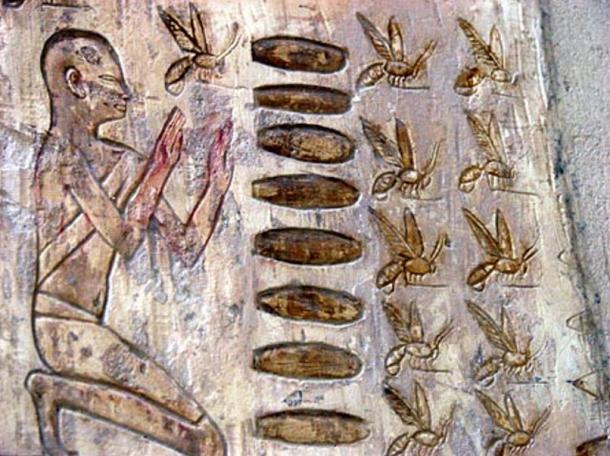
石器时代养蜂人
Stone Age Pottery Reveals Signs of Beekeeping
石器时代养蜂人
Beeswax residues found on shards of stone age pottery in the Mediterranean region indicate that humans were keeping honeybees as early as 9,000 years ago
在地中海地区发现的石器时代的陶器上检出了蜂蜡残留物,这说明了人类在9000年前就开始驯养蜜蜂。
撰文/播音 辛西娅·格雷伯(Cynthia Graber)
翻译 M
审核:邰伦玥
You have bees to thank every time you drizzle some honey into your tea. And the human-honeybee relationship is long-standing. Iconography of honeybees adorns 4400-year-old walls in ancient Egypt. Rock art has been found that depicts a stone age bee harvest. But exactly when early farmers began to exploit bees has been unclear.
每一次你往你的红茶添加蜂蜜的时候,你应该感谢蜜蜂。人类与蜜蜂的关系由来已久。蜜蜂的形象出现在距今4400年的埃及壁画上。岩画上描绘了采集蜂蜜的情景。然而,人类开始驯养蜜蜂的确切时间至今仍不清楚。
Those farmers exploited bees for more than honey. Research has shown that they also employed the beeswax for cosmetics, fuel, medicine, and to perform rituals.
那些农民驯养蜜蜂不单单为了蜂蜜。研究发现他们同样采集蜂蜡用作化妆品、燃料、药物和仪式用品。
Beeswax contains complex fats that leave a recognizable residue on pottery and other archaeological artifacts. And scientists have now used that beeswax residue to analyze what they’ve determined to be the earliest known human-and-bee association, dating back some 9,000 years.
蜂蜡含有复杂的脂类物质。这些脂类物质会在陶器和其他人造器物上留下能被检测出的残留物。而现在,研究人员通过分析蜂蜡,断定了最早的人类-蜜蜂关系可以追溯到9000年前。
The researchers surveyed Europe, the Near East and northern Africa. They found beeswax on pottery vessels from Neolithic farming sites in Anatolia, in or near modern-day Turkey. They also discovered the first evidence of beeswax at Neolithic sites in Northern Africa. And the lack of wax residues in Ireland, Scotland and the Scandanavian peninsula led them to conclude that those locations were above what must have been a northern limit for honeybees. The study is in the journal Nature. [Mélanie Roffet-Salque et al, Widespread exploitation of the honeybee by early Neolithic farmers]
研究人员调查了欧洲,近东与北非。他们在现今土耳其一带的安纳托尼亚石器时代遗址中发掘的陶器上发现了蜂蜡。他们同样首次在北非的石器时代遗址中发现蜂蜡。而在爱尔兰、苏格兰和斯堪的纳维亚半岛则缺乏蜂蜡的残留物,这使得研究者们认为这些地点处于蜜蜂所能生存的最高纬度以北。研究结果发表在《自然》上。
The researchers say that the beeswax residues at these human-occupied sites may be clues pointing to the very beginnings of bee domestication. With thousands of years of sweet results for us all.
研究人员认为在这些人类居住地发现的那些蜂蜡残留物可能是人类最初蜜蜂驯养的证据。也正是蜜蜂驯养,给我们带来了数千年的甜蜜滋味。
未经书面许可任何人不得复制或镜像
京ICP备11000850号-1
 京公网安备11010502039775号
京公网安备11010502039775号 信息网络传播视听节目许可证0111611号
国家科技基础条件平台

















